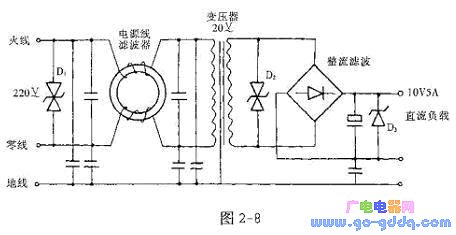When dealing with power line protection, it's essential to understand the difference between DC and AC systems. For DC lines, a unidirectional transient voltage suppression (TVS) diode is typically used, while for AC lines, a bidirectional TVS diode is required. This is because AC voltages come from the grid, which can experience random transient voltages, including those caused by lightning strikes through induction. These transients are unpredictable and hard to quantify in terms of peak power, making it crucial to select the right reverse operating voltage for the TVS.
The general rule for selecting the maximum reverse operating voltage (VRWM) for a TVS diode is to multiply the AC voltage by 1.4, ensuring it can handle the expected surges. For DC voltages, a factor of 1.1 to 1.2 is usually applied. This ensures the TVS can effectively clamp any unexpected voltage spikes without being damaged.
Figure 2-8 illustrates a schematic diagram of a microcomputer power supply that uses TVS diodes for line protection. This design helps ensure a stable and clean power supply, which is critical for reliable system operation.

The following steps are commonly taken to protect a microcomputer power supply:
- Add a TVS diode at the 220V~ line to suppress peak interference from the AC grid.
- Install an interference filter on the transformer input line to reduce small spike interferences.
- Add a TVS diode at the V~=20V output terminal to further suppress any remaining interference.
- Place a TVS diode on the DC 10V output to provide additional protection against voltage fluctuations.
For example, the VRWM of the bidirectional TVS D1 would be 220V × 1.4 = 308V, while D2 would be 20V × 1.4 = 28V, and D3 (unidirectional) would be 10V × 1.2 = 12V. These values ensure proper protection across different parts of the power supply.
After implementing these four layers of protection, the power supply becomes what is known as a "purified power supply." Additional measures can also be added to further suppress interference and prevent unwanted signals from reaching the CPU and memory of the computer, significantly improving the reliability of the entire microcomputer system.
Statistical data shows that out of 100 system failures, 90 are related to the power supply, while only 10 are due to the microcomputer itself. This clearly highlights the importance of a reliable power supply. To enhance the overall system reliability, it is vital to first improve the reliability of the power supply unit.
LED Screen,Led Video Wall Panel,Led Video Panels,Video Wall Panels
Shanghai Really Technology Co.,Ltd , https://www.really-led.com